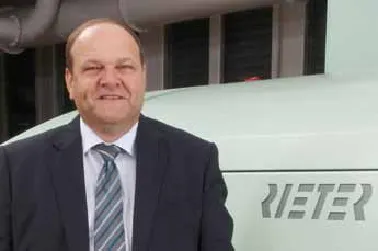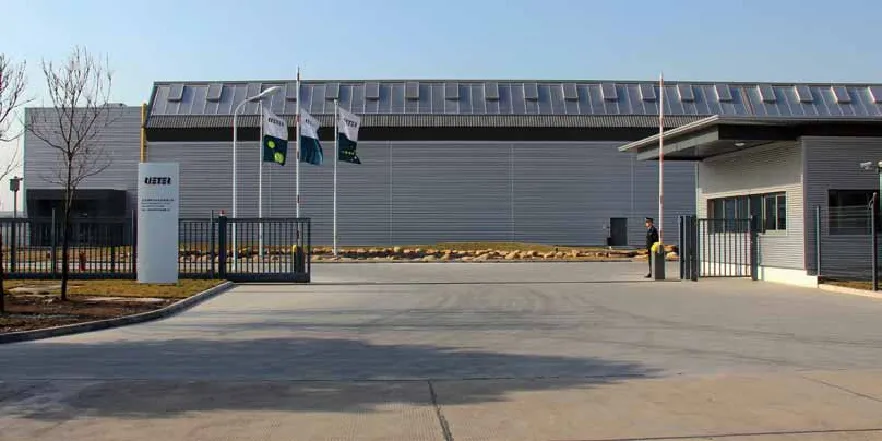立达 中国市场是重要的战略任务
2016-10-27
立达 中国市场是重要的战略任务

立达集团在中国开展业务已有80多年,被公认为短纤纺纱领域零备件、整机及全流程的市场领导者。2005年,立达集团建立了立达中华区,由立达纺织机械(上海)有限公司,立达(中国)纺织仪器有限公司,立达亚洲(香港)有限公司,台湾芮特股份有限公司组成。
如今,立达中国已拥有1000多名员工,总部位于常州,包含制造工厂和纺纱技术中心。此外,立达在上海还设有分公司,提供售后服务。在2016纺机展召开之际,本刊记者采访了立达设备与系统销售总监Reto Thom先生。
《中国纺织》:立达从哪一年开始在中国设立工厂?目前在国内主要业务有哪些?在中国市场的发展情况如何?
Reto Thom:立达在中国已经活跃很长时间了。第一台立达设备早在1927年就抵运中国,2000年立达收购了法国ICBT公司并在常州开始运行,并于2002年在常州建立了一厂,从2010至2014年,立达新工厂投资完工,纺纱中心是一个完美的收尾,为中国客户提供全面的服务。
立达在中国生产几乎所有机器,涵盖纤维开清、纺纱准备,后纺设备包括环锭细纱机、紧密纺纱机以及半自动转杯纺纱机。立达目前的发展情况良好,随着世界经济的复苏及发展,生产销售情况有显著提升。
《中国纺织》:立达以产品品质赢得国内客户的认可,立达在这方面有什么体系保证产品创新和品质稳定?公司的研发团队是如何构成的?
Reto Thom:立达在全球都实行“立达制造”标准,从开发时的质量规划,制造时的质量保证,直至使用周期内的质量提升。因此无论产品在何地制造,都能确保立达品质。
而在全球实现“立达制造”标准,离不开立达的专业团队。在开发阶段,我们拥有设计师、生产和质量专家组成的跨学科团队。在生产阶段,我们拥有专业的生产和质量专家及分析部门。在质量管理阶段,我们拥有服务、研发、生产、质量专家及分析部门。最重要的是,立达还注意倾听客户的反馈,会定期向客户发送满意度调查,并采取相应措施来改进质量。
《中国纺织》:立达的竞争优势主要体现在哪些方面?可以核心产品为例来说明。
Reto Thom:立达作为领先的纺织机械和部件供应商,专注于开发纺纱机器的自动化和低能耗,这也是立达的竞争优势所在。以立达新型喷气纺纱机J 26为例,得益于优化的吸风系统,单锭驱动和智能电源控制,压缩空气消耗的减少,高生产速度,可以显著降低能耗。而J 26纺纱单元的自动化理念能缩短接头周期,从而提高生产速度。
《中国纺织》:目前国内纺织企业需求发生了较大变化,纺织用户的需要呈现多样化和定制化趋势,您如何看待中国的纺织市场,公司是如何应对这种变化的?
Reto Thom:我们十分看好未来的中国纺纱市场。我们发现我们的客户对高度自动化、高产高效以及节能的需求日益高涨。对此,我们除了为客户提供相应设备的同时,还将建立一套全新、独立的售后业务体系,从而改善并拓展我们的服务。
《中国纺织》:从去年开始,不少纺织企业包括一些国外纺织企业开始在东南亚等国家和地区建立新厂,您如何看待这种现象?贵公司如何看待未来的中国市场?有没有向其他国家转移生产的计划?

Reto Thom:不可否认,就连中国的客户也在寻求海外市场更好的发展。这主要得益于海外市场的成本、政策利好等。但中国始终是立达全球主要市场之一,中国市场对立达的贡献越来越高,且立达在土耳其和美国等地,市场占有率也非常高,这也能有利于中国客户开拓海外市场。
《中国纺织》:2016纺机展召开在即,请介绍下此次的参展情况,重点机型有哪些,这些机型的竞争优势在哪里?
Reto Thom:大家可在展会现场看到选配P 26后可加工涤纶的喷气纺纱机J 26。机器主要的亮点在于,机器一侧加工100 %涤纶的同时,另一侧可加工涤粘混纺。立达将与客户分享利用喷气纺工艺加工各种涤纶的适用性,以及清洁周期和耐用性方面的经验。
在展台还可以看到运行中的精梳机E 86,其最大有效梳理面积结合灵活的设置有助于满足市场需求。在技术方面,立达也将证实利用精细混棉机A 81 UNIblend中精确的计量系统,其混纺效果优于并条机混纺。为了探讨最合适的纺纱工艺,1号展厅的D 01展台将同时展出所有纺纱工艺的模型,以及来自立达、格拉夫、布雷克、诺维巴和绪森的织物样品和工艺部件。
RChinesie meartkete is arn important strategical task
Rieter Group, well recognized as a leading global supplier for textile machinery and components used in shortstaple fiber spinning, has enjoyed business in China for over 80 years. In 2005,Rieter Group established Rieter China,which is composed of Rieter Textile Systems (Shanghai) Ltd., Rieter (China)Textile Instruments Co., Ltd., Rieter Asia(Hong kong) Ltd. and Rieter Asia (Taiwan) Ltd.
Today Rieter China employs over 1,000 people. Its headquarter is placed in Changzhou, including two manufacturing plants and one advanced Technology SpinCenter. The branch office in Shanghai provide after sales service.
On the occasion of ITMA AISA + CITME 2016, the reporter of China Textile found an opportunity to have an interview with Reto Thom, Head Sales Business Group RMS.
China Textile: When did Rieter start setting up factories in China?What are the main businesses in China now? How about the development in Chinese market?
Reto Thom: Rieter is active in China for a long time: The first Rieter machine was delivered to China already in 1927. In 2000 Rieter acquired a French company ICBT and started operation in Changzhou and built a Plant I in 2002,from 2010-2014, we have constructed and built Plant II with Technology Center as a perfect ending to the project to complete our services for the Chinese customers.
We produce all most all machines in China from fiber preparation, spinning preparation and from Rieter’s range of end-sinning machines we manufacture ring frames, compact spinning machines and semi-automatic rotor spinning machines. Currently, the development ofRieter is in good condition, the production and sales have significantly increased as the world economic recovery and development.
China Textile: Rieter has been well recognized by Chinese customers, and it is what kind of system that has guaranteed innovation and stable quality?What is the organization of Rieter's R&D team?
Reto Thom: Rieter implements the standard “Quality made by Rieter” all over the world, from quality planning during development, quality assurance during manufacturing, untill quality improvement throughout service life. So wherever in the world a Rieter product is manufactured - it is guaranteed Rieter quality.
And it is thanks to our professional team, so we can ensure the standard “Quality made by Rieter” all over the world. During the development process, we have interdisciplinary teams of designers, production and quality specialists. During the production process, we have production and quality specialists and analytics department. During the quality management process, we have service, development,production, quality specialists and analytics department.
The most important thing is that Rieter focuses on listening to customers, we will send our customers regular questionnaires,and implement the measures for quality improvement.
China Textile: What are the main competitive advantages of Rieter?Would you please give us an illustration with Rieter's core products?
Reto Thom: As the leading supplier of textile machine and components, Rieter focuses on the textile machine’s automation and low energy consumption, this is also Rieter’s competitive advantage.
Take our new J 26 air-jet spinning machine for example, its significantly lower energy consumption thanks to its optimized suction system, single drives, intelligent drive control, educed consumption of compressed air and high production speeds. Its spinning unit automation concept can shorten piecing cycle, thus increasing the production speed.
China Textile: Great changes have occurred to the demand of Chinese textile companies currently and the needs of textile users have been presenting a trend of diversification and customization. How do you think about Chinese textile market? How does your company deal with such changes?
Reto Thom: We have confidence in the spinning market in China for the future. We have found our customer's high demand for high automation, efficient production and energy-saving. So we will not only offer them the corresponding equipment, but also set a totally new and dependent after sales business system, to improve and develop our service.
China Textile: Many textile enterprises, including some foreign ones,have started to build new factories in southeast countries and regions since last year. What's your opinion about it?How do you view the future of the Chinese market? Do you plan to shift your production to other countries?
Reto Thom: It can not be denied that even our customers in China is searching for the better development in the overseas market. It is because of the overseas’ low cost and good policy and so on. But China is always Rieter's major market all over the world. The market in China makes contribution for Rieter becomes higher and higher. And Rieter's market share is high in Turkey, America and other countries, it is also beneficial for our Chinese customer to develop the overseas market.
China Textile: ITMA ASIA + CITME 2016 is approaching. Could you please describe for us your exhibition for it? What are your highlighted models and what are their advantages?
Reto Thom: The J 26 air-jet spinning machine with the P 26 option for processing polyester can be seen live. In line with the main focus, one machine side will be running with 100 % polyester and on the other side with a blend of polyester and viscose. Rieter shares with customers its experience on the suitability of various polyester types for processing with the airjet spinning process, as well as cleaning cycles and their durability.
The E 86 comber can also be seen in operation on the stand. Adaptation to market requirements can be realized due to its greatest active combing area in combination with the flexible setting. Rieter also simultaneously answers the technological criteria, when a tuft mixture with the precise metering system A 81 UNIblend is preferable to a draw frame blend. For the discussion on the most suitable spinning process, models of all spinning technologies are available as well as fabric samples and technology parts from Rieter, Graf,Braecker, Novibra and Suessen - on the same stand in Hall 1 Stand D 01.
